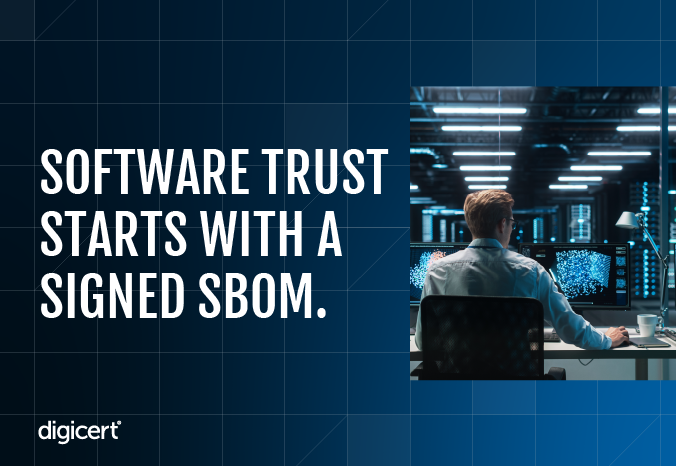6 reasons signed SBOMs are essential to software security

Picture this: you grab a quick snack before your next meeting—let’s say cheese-flavored crackers. You’re about to savor your first cracker, when that cautionary, health-conscious voice urges you to check the ingredients.

Do you eat the cracker?
If software development were cheese-flavored crackers, a signed Software Bill of Materials (SBOM) would fill the role of the ingredient list, the country-of-origin declaration, and an official food-safety seal—a comprehensive, validated, tamper-proof inventory of all components that comprise the final piece of software.
SBOMs play a critical role in not only identifying the often-numerous, distinct pieces that make up a final software deliverable, but also in validating the continuity, integrity, and authenticity of those constituent parts.
Bottom line: If you want software trust, you need a signed SBOM for every piece of software you create. Here are six reasons why.
Signed versus unsigned SBOMs
By signing an SBOM, the author of the SBOM validates the authenticity of the bill of materials at the time it’s signed. Any additions, alterations, or deletions after the moment of signing can be quickly identified as unauthorized and therefore suspect.
It also serves as a form of contract between the author of the SBOM and the down-the-line consumer. An unsigned SBOM is like an unsigned agreement. It may or may not contain the correct information, and without validation by both sides, it cannot be used to hold a party responsible should something go wrong.
1. Prevent tampering. Establish an unbroken chain of trust.
A signed SBOM is effectively a tamper-proof seal. It assures users and stakeholders that the contents of the software have not been altered since they were verified by the originator.
This is particularly important in a supply chain context, where software components often pass through multiple hands. Signed SBOMs provide a verifiable chain of custody that enhances the trust and integrity of software components.
2. Meet regulations. Show off strong security policies.
With increasing regulatory scrutiny on software security, many industries and governments are beginning to mandate the use of SBOMs. For instance, the United States Executive Order on Improving the Nation's Cybersecurity specifically highlights the importance of SBOMs in understanding and securing the software supply chain.
In such a regulatory environment, signing SBOMs not only concretely demonstrates compliance but also highlights an organization’s commitment to security best practices.
3. Mitigate the risk of open-source components. Patch and update faster.
Modern software is increasingly complex and often built on a foundation of open-source components, each of which can introduce vulnerabilities. The more components there are, the greater the scope and burden of threat detection and mitigation.
Signed SBOMs allow companies to quickly identify the status of every component and—especially if the provider of the component has issued Vulnerability Exploitability eXchange (VEX) information—much more efficiently track vulnerabilities and patch and update accordingly.
4. Provide full transparency. Make better decisions.
Transparency in the software development process has become a non-negotiable demand for both users and stakeholders. And that isn’t solely about establishing trust. Transparency also enables better decision-making. Because signed SBOMs provide full, validated disclosure of every component, developers, for instance, can make more informed choices about the components they use and avoid those with known vulnerabilities or licensing issues.
5. Streamline incident response. Minimize damage.
In the event of a security incident, time is of the essence. Signed SBOMs serve as a ready reference that can significantly streamline the incident response process. By having immediate access to a verified list of components, response teams can quickly identify affected components and take necessary actions, thereby minimizing damage and recovery time.
6. Encourage a strong security culture. Deliver better products.
The practice of signing SBOMs fits seamlessly into secure software development lifecycles, such as DevSecOps. It encourages a culture of security from the outset, where every component is individually scrutinized and verified. This proactive approach to security can significantly reduce vulnerabilities in the final product, leading to more secure software applications, greater trust, and a lower risk of post-launch problems.
Conclusion: It’s good for snack food, essential for software.
In today's software development landscape, signing SBOMs is a must. It's a practice that enhances the integrity and security of software products, meets regulatory requirements, mitigates security risks, fosters transparency, streamlines incident response, and encourages secure development practices.
As software continues to eat the world, the security of software will increasingly hinge on practices like SBOM signing. Just as health-conscious consumers check the ingredients of the foods that go into their bodies, security-conscious companies looking to build trust with users and stakeholders need to adopt SBOM signing to ensure the health of their software supply chain.
The latest developments in digital trust
Want to learn more about topics like software trust, code signing, and digital trust? Subscribe to the DigiCert blog to ensure you never miss a story.




